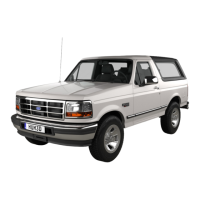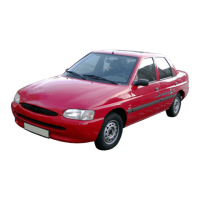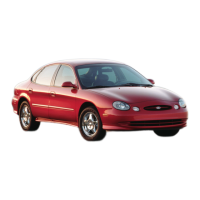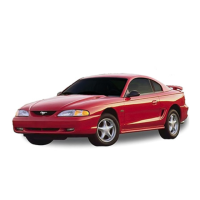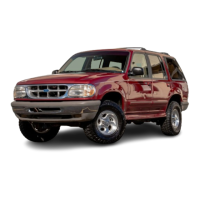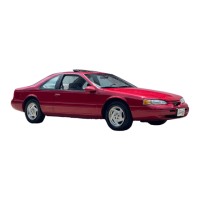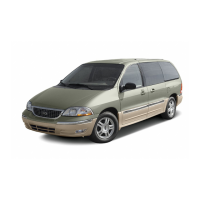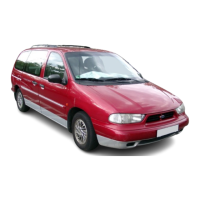
Do you have a question about the Ford 1996 Windstar and is the answer not in the manual?
| Brand | Ford |
|---|---|
| Model | 1996 Windstar |
| Category | Automobile |
| Language | English |
Company's dedication to excellence in product and service.
Core principles of quality, customer focus, improvement, and integrity.
Guidance on how to use the owner's manual effectively.
Important information and safety precautions for vehicle operation.
Instructions on how to locate specific information within the manual.
Information on obtaining owner guides in French for Canadian owners.
Details about the maintenance schedule and how to record services.
Overview of the vehicle's warranty coverage and owner rights.
Information on purchasing an optional extended service plan for your vehicle.
Guidelines for the initial break-in period of a new vehicle.
Instructions for washing and polishing the vehicle's exterior.
Specific instructions for cleaning exterior chrome and aluminum components.
Guidance on cleaning exterior plastic trim parts.
Information on the proper use and importance of safety belts.
Explanation of how combination lap and shoulder belts function and lock.
Instructions for adjusting the shoulder belt height for front occupants.
Details on the unique safety restraint system for the second row bench seat.
Description of the automatic locking mode for seat belt retractors.
Explanation of the automatic locking mode for seat belt retractors.
Instructions on how to properly adjust and wear lap belts.
Guidelines for periodically checking safety belt systems for damage.
Instructions on how to clean safety belts using mild soap solution.
Information on obtaining and using a safety belt extension assembly.
Details about the driver and front passenger air bag system.
Reasons why safety belts must be worn, even with airbags.
Explanation of how proper seating ensures effective airbag deployment.
Legal requirements and recommendations for child safety restraints.
Information on the use and specifications of built-in child seats.
Step-by-step instructions for using the vehicle's built-in child seat.
Guidelines for inspecting child restraints after a collision.
Regular inspection of built-in child seat belts and hardware.
Recommendations for children who have outgrown child safety seats.
Guidelines for selecting and installing child safety seats.
Instructions for installing child safety seats in various seating positions.
Procedure for installing a child seat in the rear center position.
Information on using tether straps for child safety seat installation.
Diagrams showing the locations of tether strap anchors in the vehicle.
Instructions for using tether anchor locations on the second row bench seat.
Instructions for using tether anchor locations on second row bucket seats.
Understanding the different positions of the vehicle's ignition switch.
Explanation of the ACCESSORY, LOCK, OFF, and ON ignition positions.
Procedure for removing the ignition key and security features.
Information specific to the vehicle's fuel-injected engine system.
Essential steps to take before starting the vehicle's engine.
Step-by-step instructions for starting the vehicle's engine.
Specific procedures for starting the engine in cold temperatures.
Specific procedures for starting the engine when it is warm.
Instructions for using the engine block heater for cold weather starting.
Troubleshooting steps for when the engine fails to start.
Information on the fuel pump shut-off switch and its reset procedure.
Safety precautions regarding exhaust fumes and enclosed spaces.
Description of the mechanical instrument cluster layout.
Description of the mechanical cluster including a tachometer.
Description of the electronic instrument cluster layout.
Details on the warning lights and gauges found on the mechanical cluster.
Explanation of various warning and indicator lights on the instrument panel.
Meaning and function of the brake system warning light.
Information on the ABS warning light and its function.
Explanation of the safety belt reminder light and chime.
Information about the Check Engine warning light and its causes.
Indicates the status of the vehicle's battery charging system.
Meaning and function of the engine oil pressure warning light.
Indicates if any door or the liftgate is not completely closed.
Indicates the operational status of the air bag system.
Explanation of the turn signal indicator lights and their operation.
Indicates when the high beam headlamps are activated.
Alerts the driver when the windshield washer fluid level is low.
Indicates when the fuel level is low in the tank.
Overview of the vehicle's gauges and their functions.
Displays the amount of fuel remaining in the fuel tank.
Indicates the temperature of the engine coolant.
Shows the vehicle's current speed in miles or kilometers per hour.
Displays the total distance the vehicle has been driven.
Records the distance traveled for individual trips.
Measures the engine's speed in revolutions per minute (RPM).
System that displays fuel economy and trip information.
Controls for operating the fuel computer functions.
Details on the different functions available on the fuel computer.
Displays the distance traveled since the last reset.
Shows the vehicle's fuel economy over the last second of driving.
Displays the average fuel economy since the last reset.
Estimates the remaining driving range based on current fuel level.
Shows the average speed traveled since the last reset.
Additional warning lights located above the driver's side vent.
Indicates when the Traction Control system is actively engaging.
Indicates when the Traction Control system is not operating.
Indicates when the optional Anti-Theft System is active.
Alerts to issues with the air suspension system.
Instructions for cleaning the instrument panel lens without scratching.
Overview of the vehicle's heating and air conditioning system.
Description of the air registers and how to adjust airflow.
Operation of the manual air conditioning controls for the front system.
Operation of the heater controls for vehicles without A/C.
Instructions on how to activate the vehicle's heating system.
Steps to quickly cool the vehicle's interior in warm weather.
Explanation of using outside air for cooling versus recirculated air.
Tips to improve fuel economy while using the air conditioning.
General tips for operating the climate control system effectively.
Information on the rear climate control system for passenger comfort.
Overview of features related to the liftgate window.
Instructions for operating the rear window defogger.
Operation of the rear wiper and washer controls.
Operation of the power-operated rear quarter vent windows.
Controls for operating exterior lighting systems.
Instructions for operating the fog lamp switch.
How to set the automatic headlamp delay system.
Procedure for adjusting the autolamp sensitivity for ambient light.
Instructions on how to clean exterior lamps without damage.
Controls for interior lighting systems.
How to turn on and adjust the brightness of instrument panel lighting.
Operation of the front dome lamp and associated controls.
Instructions for operating the map lamps for driver and passenger.
How to operate the reading lamps in the second row.
Instructions for cleaning interior dome and map lamps.
How to use the clock function on the electronic radio.
Information on the location of the radio antenna.
Description and functions of the turn signal lever.
Instructions on how to operate the turn signal indicators.
How to activate and deactivate the high beam headlamps.
Operation of the windshield wipers and washer system.
How to set the variable interval delay for the windshield wipers.
Explanation of the speed-dependent feature for wipers.
Description of the gearshift lever and its features.
Indicates the operating range of the transaxle.
How to operate the vehicle's horn.
How to activate the hazard flashers to alert other drivers.
Instructions for adjusting the steering wheel's tilt position.
Information on the cruise control system and its operation.
Step-by-step guide to setting the cruise control speed.
Procedures for adjusting or resetting the cruise control speed.
Methods to cancel or turn off the cruise control system.
How to resume a previously set cruise control speed.
Indicates when the speed control system is active.
General information about the vehicle's doors.
Instructions for opening and closing the sliding door.
How the doors automatically lock after being opened.
Description and operation of the childproof lock for the sliding door.
Procedure for setting the childproof lock on the sliding door.
Procedure for releasing the childproof lock on the sliding door.
Operation of the power door lock controls.
How to use the keyless entry system to lock/unlock doors.
Instructions for programming a personal code for the keyless entry system.
Procedure for erasing a programmed personal code.
Steps for unlocking vehicle doors using the keyless entry system.
Feature that prevents battery drain from interior lamps.
Operation of the remote entry system for locking/unlocking and alarm.
Instructions for replacing the batteries in the remote entry transmitter.
Information on replacing or adding remote entry transmitters.
System that illuminates interior courtesy lamps upon entry.
Description of the automatic door locking feature.
Information on the vehicle's anti-theft system and its purpose.
Procedure for arming the anti-theft system.
How to disarm the anti-theft system when it has not been triggered.
How to disarm the anti-theft system after it has been triggered.
Step-by-step guide to opening the vehicle's liftgate.
Step-by-step guide to closing the vehicle's liftgate.
Information regarding the vehicle's window systems.
Operation of power windows with accessory delay feature.
How to use the one-touch power window feature.
Procedure to cancel or reactivate the one-touch down feature.
Operation of the manual flip-open quarter windows.
Operation of power-operated rear quarter vent windows.
Information related to the vehicle's seating.
General instructions for adjusting vehicle seats.
How to manually adjust the front seats forward or backward.
How to tilt the passenger side second row bucket seat forward for access.
Information on the adjustable third row passenger bench seat.
Instructions for converting seats into a bed.
Details on the second row seat conversion to a bed.
Instructions for converting the third row seat to a bed.
Procedure for converting the seat/bed back to a seat.
Instructions for removing the vehicle's seats.
Procedure for removing quick-release second row bucket seats.
Instructions for cleaning leather, vinyl, and fabric seats.
Cleaning recommendations for leather and vinyl seat surfaces.
Cleaning recommendations for fabric seat surfaces.
Information on the vehicle's various storage compartments.
Details on the storage compartment located under the front passenger seat.
Information on the CD and cassette storage console.
Features and operation of the vehicle's console.
Location and operation of the vehicle's cupholders.
Information regarding the vehicle's mirrors.
Details on adjusting and using the side view mirrors.
How to adjust power-operated remote controlled side mirrors.
Operation of the heated side view mirrors.
How the automatic dimming rearview mirror functions.
Information on the illuminated courtesy mirrors on the sun visors.
Instructions for installing and using the cargo net.
Information on the roof rack and its load capacity.
Description of the radio combined with a CD player.
Instructions for operating the radio and CD player.
Steps to power the radio on and off.
Instructions for increasing or decreasing the audio volume.
How to select AM, FM1, or FM2 frequency bands on the radio.
Methods for tuning radio stations using the system controls.
Procedure for manually tuning radio stations using the SCAN/TUNE button.
How to automatically find listenable stations using the SEEK function.
How to scan for radio stations using the SCAN/TUNE button.
Instructions for storing radio stations into memory preset buttons.
Features for automatically loading and storing radio stations.
How to adjust bass, treble, balance, and fader settings.
How to view and set the clock on the radio display.
Procedure to switch the radio display to clock mode.
Instructions for operating the compact disc player.
Steps for inserting a disc and starting playback on the CD player.
How to temporarily stop and resume playback on the CD player.
Procedure for fast forwarding or reversing tracks on the CD player.
How to use the SEEK feature to find tracks on the CD player.
How to use the SCAN function to preview CD tracks.
Description of special features like compression and auto storage.
How the compression feature enhances listening level consistency.
How the CD player automatically reloads ejected discs.
Procedure for ejecting a disc from the CD player.
Precautions for maintaining the performance of the CD player and discs.
Description of the high-level audio system's performance.
Methods for tuning stations on the stereo radio.
Procedure for manually tuning radio stations.
How to automatically select listenable stations.
Methods for tuning stations on the stereo cassette radio.
Procedure for manually tuning radio stations.
How to manually tune using the AMS function on the cassette radio.
How to automatically select listenable stations.
How to scan for stations using the SCAN function on cassette radio.
Instructions for setting radio station memory presets.
How to adjust bass, treble, balance, and fader settings.
Methods for finding specific tracks on a cassette tape.
How to use AMS function to find tracks on cassette player.
How to use AMS function with display arrows for cassette tape.
How to select the alternate side of a cassette tape.
Procedure for ejecting a cassette tape from the player.
How to activate and use the Dolby B noise reduction feature.
Precautions for maintaining the cassette player and tapes.
Information on common error codes displayed by the cassette player.
How to view and set the clock on the radio display.
Instructions for setting the clock time on the radio.
Factors affecting FM radio reception quality.
Details on warranty coverage and service options for the audio system.
Overview of the automatic transaxle system.
Instructions on how to select the correct gear for driving.
Explanation of the safety feature preventing gear shifts without brake pedal.
General advice and guidelines for operating the vehicle.
Situations and conditions for using the Neutral gear position.
Guidelines for using the Overdrive gear for normal driving.
How to use Drive mode with overdrive deactivated for engine braking.
How the transaxle performs forced downshifts for acceleration.
Information on how traction control improves vehicle handling.
Explanation of the power steering system and its operation.
Overview of the vehicle's braking system components.
Information on the self-adjusting front disc brakes.
Information on the self-adjusting rear disc brakes.
Explanation of the Anti-lock Brake System (ABS) and its function.
Factors affecting vehicle stopping distances.
Technique for applying the vehicle's brakes smoothly.
Instructions on how to set and release the parking brake.
Advice for driving the vehicle in various challenging conditions.
General safety tips for driving the vehicle.
How to handle and prevent wheel spin during driving.
Precautions and advice for driving at high speeds.
Specific driving advice for various bad weather conditions.
Precautions for driving on wet or snowy roads.
Advice on driving through flooded areas.
Technique for freeing a stuck vehicle by rocking it.
Guidelines for driving the vehicle safely with a heavy load.
Information on vehicle and trailer weight capacities.
Essential advice and precautions for towing a trailer.
Understanding vehicle load capacity designations.
Definitions of terms related to vehicle load capacity.
Definition and calculation of maximum allowable payload.
Definition of Gross Vehicle Weight (GVW).
Definition of Gross Vehicle Weight Rating (GVWR).
Definition of Gross Axle Weight Rating (GAWR).
Definition of Gross Combined Weight Rating (GCWR).
Steps to calculate the vehicle's payload capacity.
Information regarding the proper weight distribution for trailers.
Ensuring the vehicle and trailer are properly equipped for towing.
Recommendations for selecting appropriate trailer hitches.
Importance and proper use of safety chains when towing.
Requirements for trailer brake systems on heavier trailers.
Ensuring trailer lamps conform to regulations.
Special precautions for driving while towing a trailer.
Maintenance recommendations for vehicles that tow trailers frequently.
Practical tips for safely maneuvering vehicle-trailer combinations.
Procedure for jump-starting a vehicle with a dead battery.
Steps to take before connecting jumper cables for a jump-start.
Correct procedure for connecting jumper cables to batteries.
Instructions for safely changing a flat tire.
Information and precautions for using the temporary spare tire.
Location of the spare tire and its storage.
Step-by-step instructions for removing the spare tire.
Procedure for safely lifting the vehicle and changing a tire.
Instructions for removing the wheel cover to access lug nuts.
Instructions for properly stowing the spare tire after use.
Information about the fuel pump shut-off switch and its function.
Information and recommendations for towing your vehicle.
Details on the 24-hour roadside assistance program.
Steps to follow when experiencing a service or maintenance issue.
Process for obtaining service or maintenance at a dealership.
Contact information for customer assistance in Canada.
Contact information for customer assistance outside North America.
Information on the voluntary dispute settlement program for owners.
Types of complaints reviewed by the Dispute Settlement Board.
Explanation of the structure and process of the Dispute Settlement Board.
Instructions on how to contact the Dispute Settlement Board for information.
Details on the process for reviewing a complaint with the Board.
How to report vehicle safety defects to NHTSA and Ford.
Advice for obtaining assistance when exporting a vehicle internationally.
Contact information for Ford Motor Company of Canada customer assistance.
Information on the CAMVAP dispute resolution process for Canadian owners.
Overview of available accessories designed for the Windstar.
Categories of accessories for safety, comfort, and convenience.
Accessories focused on enhancing comfort and convenience.
Accessories designed for vehicle protection and appearance enhancement.
Available audio system accessories.
Available safety equipment accessories.
Accessories designed for travel and cargo carrying.
Information about the vehicle's console options.
Ford's approach to making vehicle servicing straightforward.
General safety precautions to follow when servicing the vehicle.
Safety guidelines and procedures for working in the engine compartment.
Step-by-step instructions for opening the vehicle's hood.
How to properly secure the hood using the prop rod.
Procedure for safely closing the vehicle's hood.
Diagrams and identification of key components in the engine compartment.
Essential checks to perform when stopping at a service station.
Step-by-step instructions for refueling the vehicle's fuel tank.
Guidance on selecting the correct type of fuel for the vehicle.
Recommended octane rating for the vehicle's gasoline.
Information on fuel quality and its impact on vehicle performance.
Information on approved gasolines and oxygenate content.
Important safety precautions when handling automotive fuels.
Procedure for restarting the vehicle after running out of fuel.
How to estimate and calculate the vehicle's fuel economy.
Understanding EPA fuel economy estimates versus real-world conditions.
Tips and driving habits to improve vehicle fuel economy.
Recommended engine oil types and specifications.
Procedure for checking and adding engine oil to the vehicle.
Detailed steps for checking the engine oil level using the dipstick.
Information on engine coolant, its function, and maintenance.
How to check the engine coolant level and its importance.
Instructions on how to add engine coolant to the vehicle.
Information on engine coolant freeze protection and mixture ratios.
Inspection of engine and heater hoses for wear and leaks.
Procedure for draining and flushing the engine coolant system.
Information on the vehicle's battery and its maintenance.
Guidelines for replacing the vehicle's battery.
Recommendations for recycling used lead-acid batteries.
Maintenance and operation of the windshield washer fluid and wipers.
How to check and add windshield washer fluid.
Checking and replacing windshield wiper blades.
Information regarding tire inspection and maintenance.
Procedure and benefits of rotating vehicle tires.
Guidelines for rotating tires to ensure even wear.
When and how to replace vehicle tires.
Explanation of tire quality grades and their meaning.
Understanding the treadwear grade of tires.
Tire traction grades and their meaning.
Tire temperature grades and their meaning.
Advice on using snow tires and chains in winter conditions.
Instructions for cleaning vehicle wheels.
Information on automatic transaxle fluid and its maintenance.
Procedure for checking the automatic transaxle fluid level.
Instructions on how to add automatic transaxle fluid.
Information on brake fluid, its level indicator, and checking.
How to check and maintain the power steering fluid level.
Explanation of fuses and maxi-fuses protecting the electrical system.
Procedure for checking and replacing blown fuses.
Explanation of relay function in vehicle electrical systems.
Checking the operation of various vehicle lights.
Instructions for replacing headlamp bulbs.
Steps for installing a new headlamp bulb.
Procedure for removing and replacing taillamp bulbs.
Steps for removing a taillamp bulb.
Instructions for removing and installing fog lamp bulbs.
Chart listing bulb types and their trade numbers for replacement.
Information on the vehicle's emission control system and catalytic converter.
Recommendations for maintaining the emission control system.
Information on preparing the vehicle for I/M tests.
Steps for completing the OBD II drive cycle for system readiness.
Table of fluid capacities for various vehicle components.
List of recommended Motorcraft parts for the vehicle.
Specifications for lubricants and fluids used in the vehicle.
General maintenance recommendations for storing the vehicle.
Basic guidelines for storing the vehicle in a dry, ventilated place.
Body care recommendations for stored vehicles.
Engine maintenance procedures for vehicles in storage.
Fuel system maintenance for extended vehicle storage.
Protecting the cooling system against freezing temperatures.
Battery maintenance for stored vehicles.
Ensuring brakes are released before vehicle storage.
Maintaining recommended tire air pressure during storage.
General maintenance tips for linkages, cables, and moving parts.
Engine specifications for GL, LX, and GL trims.
Fuel type and octane recommendations.
Fuel tank capacity in gallons and liters for different models.
Tire size specifications for GL, LX, and GL trims.
Information on checking tire pressure.
Location of the hood release lever.
Recommended engine oil type and viscosity.
Engine oil capacity with and without filter change.
Capacity of the automatic transmission fluid.
Specifications for power steering fluid.
Engine coolant capacity with and without rear heater.

